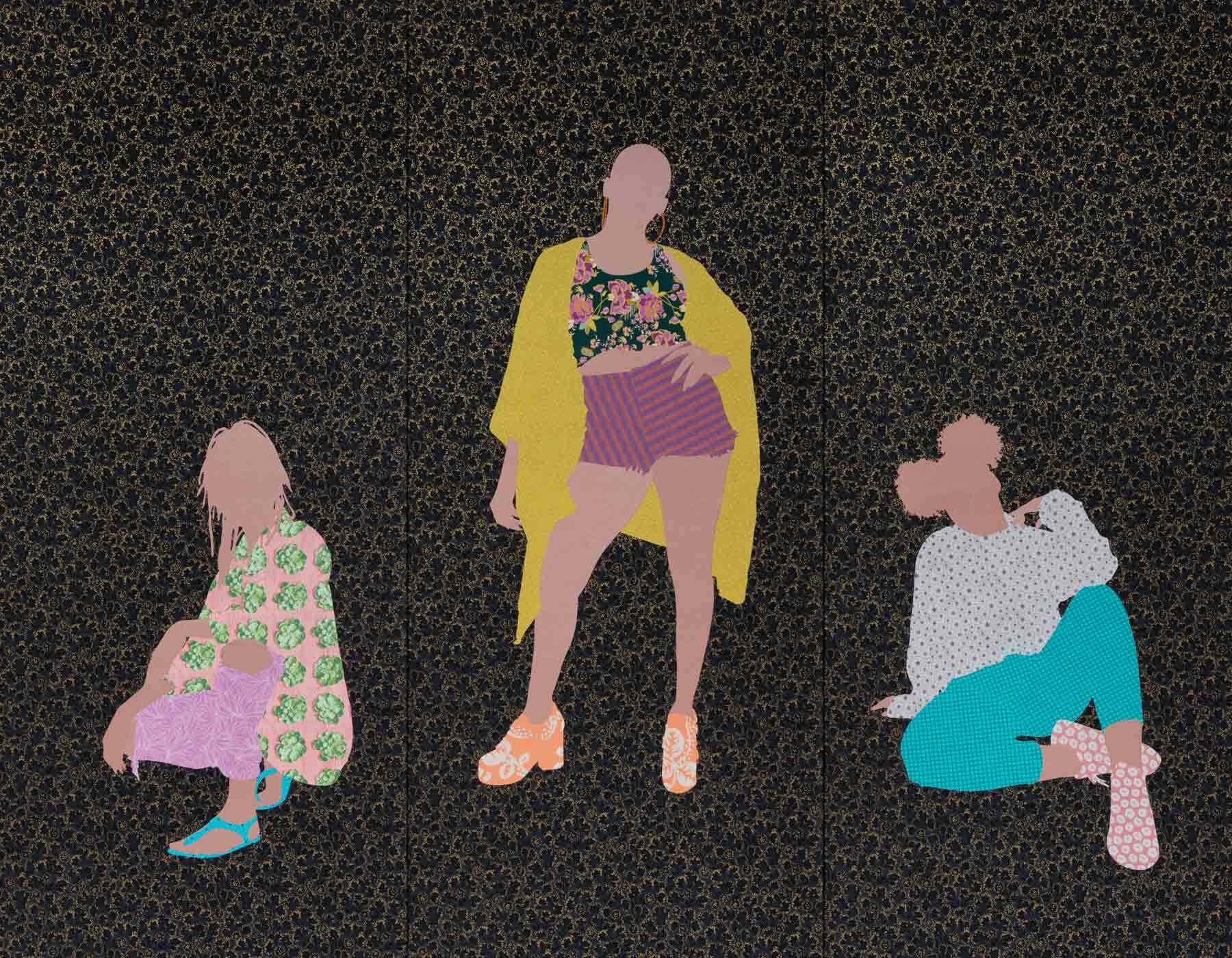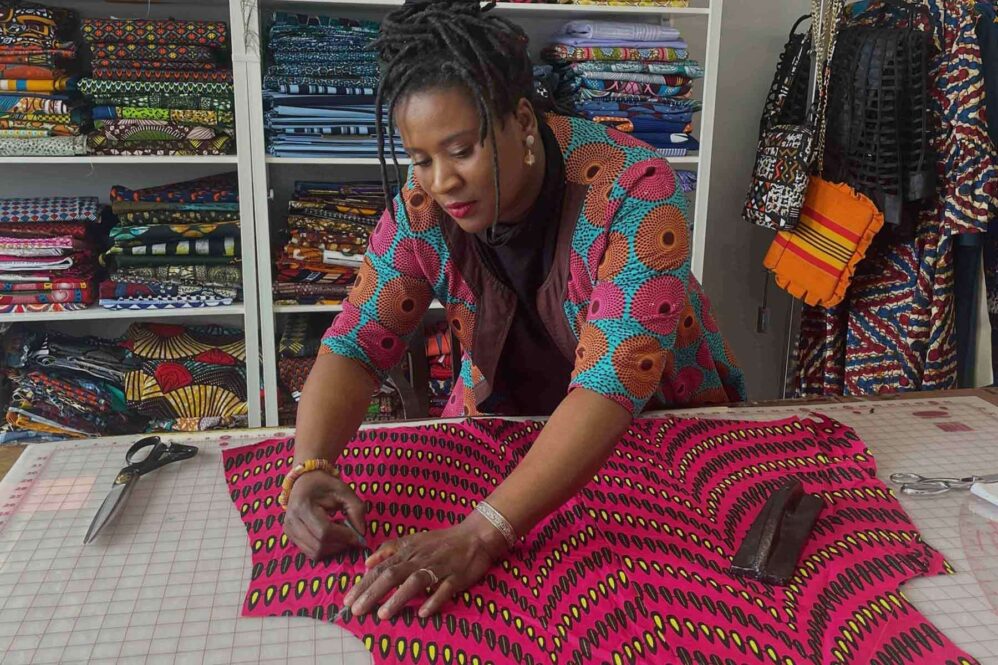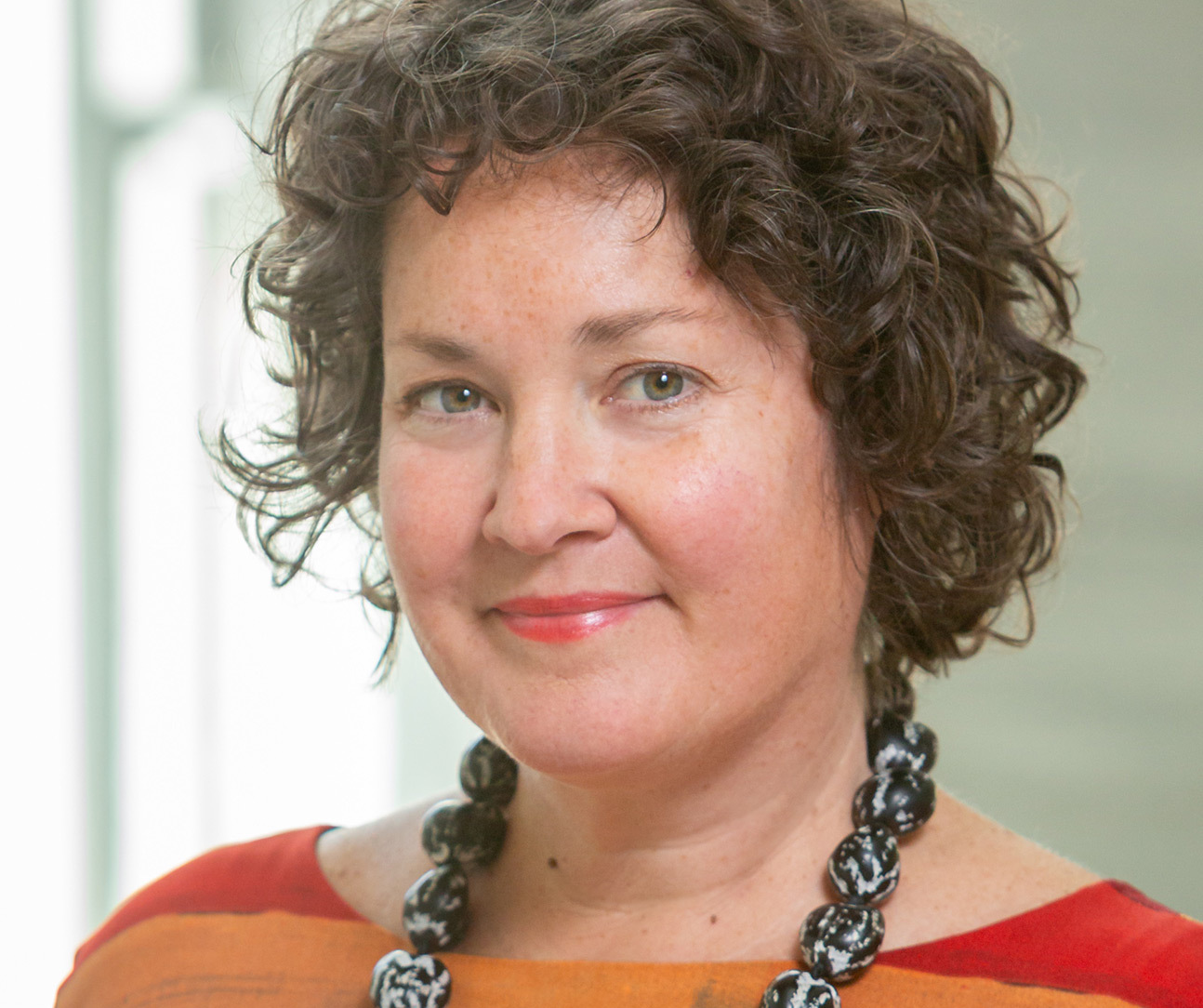TOP IMAGE: Gio Swaby, Artist in Studio studio. © 2023 Peabody Essex Museum. Photo by Anthony Gebrehiwot.
Gio Swaby is a multidisciplinary artist exploring the intersections of Blackness and womanhood. Swaby was born in 1991 in the Bahamas and works in Canada. She creates portraits of women from her own tight social circle using a range of textile-based techniques. The portraits are anchored in the artist’s desire to represent and celebrate the complex ways women style themselves. Swaby forges close connections with her subjects – each portrait begins with a photo shoot where the artist invites women to show up as they are, wearing what makes them feel comfortable and confident. As Swaby takes photos, she notes the moments when the women relax, and come into a sense of self-awareness and empowerment. These moments inspire Swaby’s portraits as well as her selection of fabrics and threads. She upends tradition with her often life-size portraits, which give a sense of monumentality to the techniques of embroidery and piecing. She also presents the reverse side of her intricately rendered canvases so that the stitching process of her freehand style — with its normally hidden knots and loose threads — is visible. While there is a vulnerability to Swaby "showing the back," she embraces and elevates these imperfections. Gio Swaby: Fresh Up is at PEM August 12 through November 26, 2023.
Q: What does “Fresh Up” mean?
A: Fresh up is a part of Bahamian dialect. It's how you give someone a compliment. It doesn't even have to be dressing up. It can just be a way of carrying yourself. You get a new haircut and it brings out a confidence in you. You can say to someone, "Oh, you get all fresh up today," or, "You're looking fresh up." It's just a way to connect in a really positive energy. That exchange of energy between the person giving the compliment and then receiving it. Then you can see the boost in people.

Gio Swaby, Gyalavantin’, 2021. Thread and fabric appliqué on canvas. Courtesy of the Claire Oliver Gallery and the United States of America Embassy Nassua, Bahamas, © Gio Swaby.
Q: How and when did you start working with textiles?
A: Textiles have been a part of my life for pretty much my whole life. I've always been in a house full of fabric, full of thread, sewing machines, because my mother was a seamstress from well before I was born. She'd make matching outfits for all of us and also for herself. That's how I learned to sew. We learned to sew these doll clothes together, making them from socks and other materials we had around the house, and then moving into something more complicated. Every school in the Bahamas wears a school uniform. She made all my school uniforms. I'd help her with that too a little bit, like sewing on the buttons, putting on the hooks on the skirt. Those were really special moments for us. I felt like, "This is our connection. "
Q: How did growing up in the Bahamas affect the color patterns that you work with? And how and when did you start working with textiles?
A: For fabrics, my choice is always vibrance. I work with a lot of color. Being someone from the Caribbean, color is a part of life in a way that is hard to see or hard to experience in other places. In other cities, when you walk around, everyone's in all black. You probably will never have that moment in the Bahamas. People gravitate toward color. For me, that has been true in my work and my personal life, which the two are very intertwined. I work with a lot of florals in my fabrics as well. I've always been drawn to flowers, a very strong motif throughout my work, through the very different ways that we can communicate with flowers, what they might mean. Even the placement of them (is it upright or upside down? ) and what that might indicate for a portrait.

Q: You often foreground the hairstyle of your sitters. Why is this?
A: For me and for a lot of Black women, hair's always a complicated journey. It's incredibly important as a part of our culture. For Black women globally, hair is a very important part of our identity and the way that we present ourselves. The series of portraits that has a focus on hair is a way for me to celebrate the incredible artistry of Black hair. The way we've been able to develop an encyclopedia of hairstyles and methods of hair care is for me so incredible to have this wonderful connection between all of us. It brings together many different kinds of people.
Gio Swaby. Photo by Anthony Gebrehiwot © 2023 Peabody Essex Museum.
I think that it also is a connection to lineage and ancestry. For me, being a person from the Caribbean, being from the Bahamas, tracing back ancestry is difficult. The record-keeping only goes back so far. There's a history in the diaspora of enslavement and how being stolen and taken away has really broken down our ability to trace back where we've come from. Looking at images from hundreds of years ago, you can see the similarities in hairstyles. I can still see some of the same hairstyles, some of the same methods of hair care, which to me is showing that there's still this connection.
Q: What does it mean for you to be able to have Black women and girls, such as your sisters and friends, represented on the walls of galleries and museums?
A: I am making art for black people. I want my art to be seen by people who perhaps don't have a strong background in art. These textile portraits are my attempt at decolonizing portraiture. I'm approaching these portraits with an extremely high level of respect and reverence and a dedication to the person represented. I think that they can see that when they see the piece. It really is immortalizing someone through portraiture. I didn't know a lot about art. I didn't know any artists. My family was not a go-to-the-museum or art-gallery kind of family.

I think seeing this work would have made a difference in how I felt and navigated the world. I could have seen this and saw that that could be something that I could do. Sometimes you need to have an example to really access your full potential. Having that example would have made such a strong impact for me. Of course, I found my way to it.
Gio Swaby, New Growth Second Chapter 11, 2021. Thread and fabric appliqué on canvas. Collection of The Altman Family, © Gio Swaby.
To hear more of Gio Swaby discussing her work, go listen to the episode of our PEMcast called following the thread. Featuring interviews with Swaby, Chinese artist Gu Wenda and PEM curators Trevor smith and lan Morgan, this episode is all about hair. And on August 3, we'll be hosting a sold out moth storyslam. Audiences will listen to captivating tales from the community or prepare a five-minute story about your tresses. Exciting chops and coiffed mop tops, moisturized coils getting tangled or untangled in one swoop. Rocking a new do: bangs, fauxhawks, afros, crewcuts, French braids, locs or shaving it all off. Getting it straight, smoothing it out or letting it down. Reinventions, redos, blow-outs and blow-ups. We'll be regaled with tales about loving, losing, reclaiming or removing all things hairy.
Keep exploring
PEMcast
Following the Thread: PEMcast 30
30 min listen

Blog
my pretty side frays: Chenoa Baker shares an inside look at Gio Swaby’s creative process
7 min read

Blog
A Studio Visit With Queen Adeline
6 Min read

Past Exhibition
Gio Swaby: Fresh Up
August 12 to November 26, 2023

